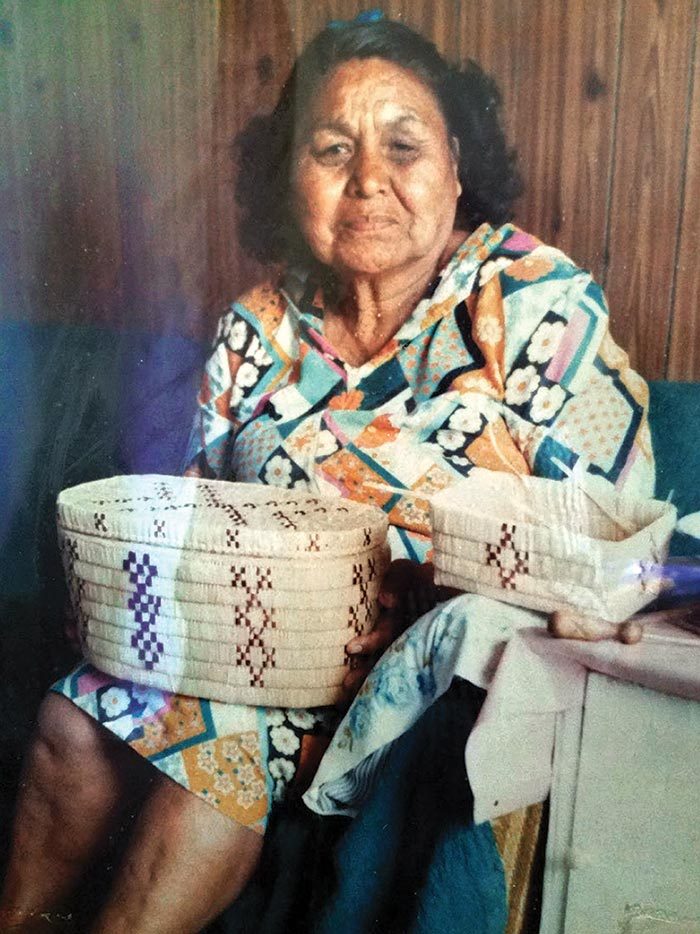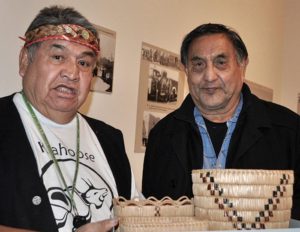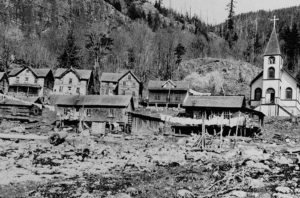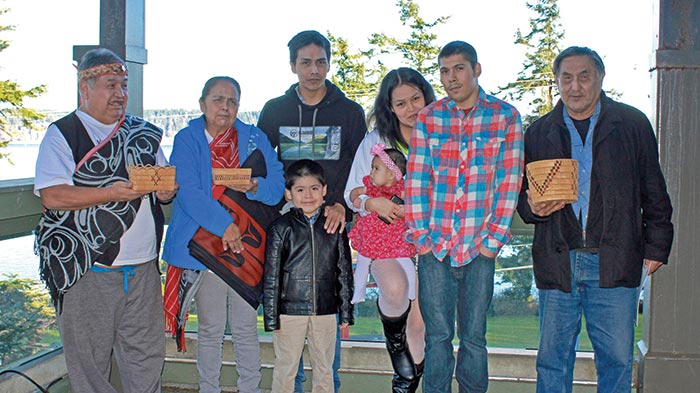Louise Harry: A weaver unlike any other
The legacy of an innovative and unique basket maker—Louise (Francis) Harry—was celebrated in an intimate ceremony at the Museum at Campbell River in early February.
People from Klahoose and Homalco (Xwemahlkwu) nations gathered with friends and neighbours to honour the memory and the work of a woman and an artist.
In the room were two of Louise Harry’s sons, Norman Harry Sr. and Leonard Pielle. A song was sung, blanketing took place, witnesses were recognized and memories were recorded.
Also attending were Colin Gabelmann and partner Robin Geary. Although Gabelmann is best known as a long-time BC member of the legislature and former attorney general, he and Geary were there as friends of Louise and her family. They presented the family with copies of a book they had published for the event titled simply Louise (Francis) Harry – Weaver.
In the credits for the book, Gabelmann wrote: “This project was inspired by the desire of Norman Harry and his family on Cortes Island to leave a legacy of his mother’s work for future generations.”
He told the gathering that “Our relationship began almost 40 years ago. A bond with the Harry family developed quite quickly.”
A few years ago, Gabelmann said, “Norman asked about getting his mother’s baskets back. We collected photos of all the baskets we could find.”
Many of those photographs, along with a family tree, illustrate the 20-page book.
Born at Church HouseLouise Harry was born in the Homalco community of Church House at the entrance to Bute Inlet in 1911, according to information provided by the museum and its curator Beth Boyce.
“Church House was a relatively new community then, with the Homalco people having moved there about a decade earlier after their village of Mushkin, on the east coast of Sonora Island, was destroyed by one of the infamous Bute winds.
“Louise was part of a large family with several older sisters and a number of brothers. Little is known about her father, George Francis, but we do know that her mother, Mary Madeline (Wilson), was a talented basket maker.
“Three of Mary’s baskets are in the collection of the Museum at Campbell River. At least one of Louise’s older sisters, Theresa (Leo), is also known to have made baskets, though sadly no examples of her work have been located.
“In 1931, Louise married a Klahoose man named Tommy Piel(le), the brother of basket makers Jeanne (Dominick) and Anne (Chapman). The couple settled in the Klahoose community of Squirrel Cove and had two children before Tommy was lost in a fishing accident. Louise remarried several times and had several other children. Her last marriage was to George Harry. Louise died in Campbell River in 1987. She was 75.”
The museum calls Louise Harry’s basketwork “innovative, distinctive and stylistically consistent.”
The basket bottoms had an unusual feature with the slats narrower than those forming the walls.
But it was the materials that Louise used for her work that really stood out. The museum said she was “the only northern Coast Salish basket maker known to have worked with hemlock root as well as the more commonly used cedar and spruce roots.
“Two baskets in the (museum’s) collection were purchased directly from Louise, who specifically stated that she had made them of hemlock rather than cedar or spruce root. The hemlock root is whiter in colour than both the cedar and spruce and has a duller sheen.”
Another distinctive feature of her baskets was that only cherry bark was used for decoration using either a red (natural) or black (dyed) bark.
“On all of the examples of her work included in this inventory the colour white or yellow is entirely absent from the applied designs. This is unusual for northern Coast Salish baskets.”
Museums and First Nations
Chief James Delorme of Klahoose First Nation helped coordinate the ceremony. Ken Hanuse as a speaker, drummer and singer assisted him.
After the event, Delorme said he viewed the ceremony as a form of reconciliation.
“The relationship between First Nations and museums is important. Museums generally do not give back artifacts they collect, but there are ways for the two groups to come to an agreement.
“Reconciliation took place through Colin Gabelmann working with the museum,” Delorme said.
While he recognized the important role that museums have in caring for artifacts, the Klahoose chief said his community was working on an opportunity for building its own facility that would include both a cultural centre and museum.
Work of three nations
The Museum at Campbell River recognized the close ties between Homalco, Klahoose and Tla’amin (Sliammon) people. In addition to Louise Harry, makers of baskets in its collections include:
- Mary Madeline (Wilson) Francis was born in 1883 and her baskets are believed to have been made around 1918.
- Annie (Pielle) Chapman was born in 1885. Her baskets were made using cedar root rather than pine needles, a unique feature for northern Coast Salish work.
- Elizabeth (McGee) Wilson, was born in the 1880s. Her father, Opanius, was identified as the hereditary owner of the Upper Toba River watershed.
- Annie Wilson (Harry) was born in 1880 and lived until 1972. She was the daughter of former Homalco chief George Harry and Theresa Bob of Sliammon and harvested all her own basketry materials.







